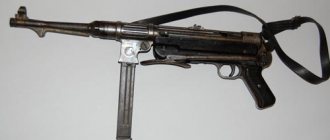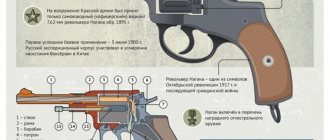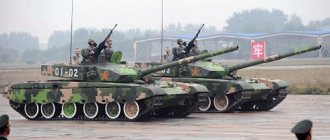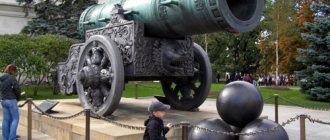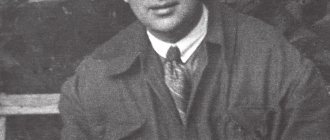On August 5, 1905, aircraft designer Artem Mikoyan was born. The machines created under his leadership went down in the history of not only domestic, but also global aircraft construction. Our famous MiGs have set over 110 world records, and the name of the design tandem of Mikoyan and Gurevich has become the most famous Russian aircraft brand in the world. For several decades, Mikoyan's design bureau provided the Soviet Air Force with high-quality competitive aircraft. Many A.I. aircraft Mikoyan were the first in their classes and are still used in many countries.
Artyom-Anushavan
If today we conduct a survey in different countries of the world about which Russian aviation brand is best known, then we can confidently say that MiG will win.
Soviet and then Russian MiGs earned the respect of their enemies. In the elite units of the US Air Force, a patch with the inscription “Kill the MiG!” is common. Such recognition is expensive, especially since during their career the MiGs have proven in practice that they themselves can kill anyone who stands in their way.
The history of the appearance of the famous brand was not easy, just like the life of its creator, Soviet aircraft designer Artyom Mikoyan .
Artyom Ivanovich Mikoyan was born into a poor peasant family in the mountain village of Sanahin, Borchalinsky district, Tiflis province, on August 5, 1895. The name and patronymic “Artyom Ivanovich,” familiar to the Russian ear, appeared later, and at birth the future creator of aircraft was Anushavan Ovanesovich .
Artyom's older brother Anastas Mikoyan became a revolutionary and later a prominent Soviet political figure. It was about him that the famous saying “From Ilyich to Ilyich without a heart attack or paralysis” was composed.
Results
The design bureau of Mikoyan Gurevich is the real pride of our country, which is capable of creating the most modern technology that guards our borders. Throughout history, more than 400 models and modifications of aircraft have been developed, 170 of them were prototypes, and 94 were mass-produced. In total, during the history of the Mikoyan Gurevich Design Bureau, about 55,000 aircraft under the MIG brand rolled off the assembly line, 14 thousand abroad under license. Test pilots on the planes instantly set more than 100 world records for rate of climb, maximum speed and flight altitude, for which 19 pilots immediately received the title of heroes of the Soviet Union and the Russian Federation. The title of Hero of Socialist Labor was twice awarded to A.I. Mikoyan and R.A. Belyakov. Titles of Hero of Socialist Labor - designers M.I. Gurevich, A.G. Brunov, N.Z. Matyuk, G.E. Lozino-Lozinsky, K.K. Vasilchenko, M.R. Waldenberg.
Turner at party work
After graduating from two classes of a rural school, in 1918, 13-year-old Artyom moved to Tiflis, to live with relatives, where he continued his studies at an Armenian school. The revolutionary spirit of his older brother also affected Artyom: in 1921, he arrived in his native village and created the first Komsomol cell there.
In 1923, Anastas Mikoyan, who worked in Rostov-on-Don, called his younger brother to his place. In Rostov, Artyom worked at an agricultural machinery factory as a turner, while continuing his studies at evening school. In 1925, Mikoyan Jr. was accepted into the party.
Article on the topic
Symbol of the era. Who killed 26 Baku commissars
In the same year, Artyom went to Moscow, having a letter of recommendation from his older brother, to Ekaterina Sergeevna Shaumyan , the widow of Stepan Shaumyan , one of the executed 26 Baku commissars, whom Mikoyan Sr. knew well. At first, Artyom, who got a job as a turner in Moscow, lived with Ekaterina Shaumyan.
In 1928, Artyom Mikoyan was recommended for party work, being appointed secretary of the party organization of the October Tram Park. In those distant times, however, party activity did not exempt him from military service, and in December 1928 Mikoyan went to do military service.
After returning from the army, Artyom Mikoyan became secretary of the party organization.
To aviation according to the order
All this activity was very far from aviation and aircraft manufacturing. But the life of the young party functionary changed dramatically after in January 1931, the IX All-Union Congress of the Komsomol adopted a resolution on the patronage of the Komsomol over the Air Force.
The aviation industry needed new personnel, and thousands of young communists and Komsomol members were sent to study at the relevant universities.
Responsible, disciplined and efficient, Artyom Mikoyan was recommended for admission to the Zhukovsky Air Force Academy.
It would be a gross exaggeration to say that for Mikoyan this was a lifelong dream. In addition, he clearly lacked education. But if the party said “must”, then the task had to be completed. After completing the preparatory courses, Artyom Mikoyan passed the entrance exams.
Mikoyan studied with complete dedication, without sparing himself. In addition to the training program at the academy, he mastered parachute jumping.
In 1935, Mikoyan underwent practical training in Kharkov, at the design bureau of a local aircraft plant. Upon his return, together with his classmates Samarin and Pavlov , Mikoyan designed the light aircraft “Oktyabryonok” - this was the first independent work of future aviation engineers.
Young specialist
On October 22, 1937, Artyom Mikoyan defended his graduation project and left the academy with the rank of military mechanical engineer of the Red Army Air Force.
The young specialist was appointed as a military representative at State Aviation Plant No. 1, where he established himself as an excellent specialist.
But there is a long distance from an excellent mechanical engineer to an aircraft designer. In February 1939, the design bureau of one of the leading specialists of that time, Nikolai Polikarpov, .
Article on the topic
The tragedy of Nikolai Polikarpov. The last plane of the king of fighters
Nikolai Polikarpov, a student of the famous Igor Sikorsky , was a difficult man, in conflict with the authorities, who had an overturned death sentence on charges of sabotage. At the same time, he was called the “king of fighters,” since it was his machines that formed the basis of the pre-war fighter aviation of the USSR.
Polikarpov drew attention to Mikoyan, who stood out for his efficiency, desire to delve into the most complex nuances and put forward his own proposals. Polikarpov instructed Mikoyan to work on the I-153 Chaika fighter. It all started with testing small arms on the three lead aircraft of the project, but then the young engineer became increasingly involved in working on improving aircraft, sometimes going beyond the instructions he received from Polikarpov.
"Russian Farman". Igor Sikorsky revolutionized world aviation
Read more
Where did the MiG begin?
During this work, Mikoyan became close friends with the head of the department of the group of general types of the Polikarpov Design Bureau, Mikhail Gurevich . This is how a tandem of designers began to form, which later became famous throughout the world.
Article on the topic
Wings for the Motherland. Andrei Tupolev taught Russia to fly
We are approaching the most delicate moment in the biography of Artyom Mikoyan. In 1939, while Nikolai Polikarpov was on a business trip abroad, the management of aircraft plant No. 1 decided to create an Experimental Design Department, which included some of the Polikarpov Design Bureau specialists. Artyom Mikoyan became the head of OKO, and Mikhail Gurevich became his deputy. The new structure was given the development of the promising I-200 fighter, work on which began at the Polikarpov Design Bureau. Subsequently, the I-200 project turned into the MiG-1 - the first development of the new design bureau.
Many aviation historians believe that Polikarpov was simply robbed, taking away a promising project and a large number of specialists from his design bureau. At the same time, they say that Artyom Mikoyan used his older brother’s connections to ensure a decision in his favor.
There is another way of looking at things. The Second World War was beginning, and no one had any doubt that the USSR would inevitably be drawn into it. The country needed to update its aircraft fleet, and the Air Force needed the most modern technology. Polikarpov’s models, which at that moment were in a high readiness stage, lagged behind the tasks of the day. The Soviet leadership strove to achieve results, moving in several directions at once. Prospective developments were entrusted to a whole galaxy of aircraft designers - Yakovlev , Lavochkin , Petlyakov , Ilyushin , Tupolev and others. The tandem of Mikoyan and Gurevich also managed to convince them of their readiness to create a modern aircraft with high performance in the shortest possible time.
Be that as it may, in December 1939 the new design bureau became a reality.
Present and future
In the 2000s, the situation seriously improved, orders and government support appeared. The MiG-29SMT was the first to take off. In 2007, the shipborne fighter MiG-29KUB entered testing, which was supposed to replace the already outdated MiG-29K.
Currently, the design bureau's main efforts are focused on creating the MiG-35, which should replace the 29th model in combat service. Flight tests will begin as planned in November 2016. What the plane will be like can only be said after the tests begin, and everything else is just our guesses.
There are also constantly flashing reports in the press about the creation of a new MiG-41 interceptor, which will have simply fantastic interception capabilities. However, so far things have not gone beyond conversations and sketches, and the VKS is completely focused on testing the T-50, which is already flying and undergoing final tests. And besides, the capabilities of the MiG-31 have not yet been completely exhausted and the aircraft can potentially fly at hypersonic speeds at certain altitudes, and modifications to the aircraft for the use of various missiles can significantly expand its functionality.
Test by war
On April 5, 1940, the new Soviet high-speed fighter MiG-1 made its first flight. The aircraft successfully passed tests and was accepted into mass production. In total, about 100 cars were produced.
Article on the topic
"MiG" glory. How Soviet pilot Privalov accomplished the impossible
The machine was created in an extremely short time, which inevitably entailed the presence of shortcomings. The MiG-1 had poor static longitudinal stability due to its rear alignment. The plane easily fell into a spin and had difficulty getting out of it. The pilot's fatigue was greater than on other aircraft.
Most of the shortcomings were eliminated in the MiG-3, which became a modification of the first machine.
At an altitude of over 7000 km, the MiG-3 developed the highest speed for production aircraft of that time - 640 km per hour. The plane had an altitude ceiling of 12 thousand meters, which made it possible to successfully fight the highest altitude enemy aircraft. From December 1940 to 1941, over 3,000 MiG-3s were produced, which took an active part in the Great Patriotic War.
However, it soon became clear that the MiG-3 was not the most advanced fighter. The main air battles took place at low altitudes, where the MiG was not maneuverable enough. As a result, the losses of aircraft of this type were very significant.
As a result, the MiG-3 was transferred to the air defense forces, where it became an ideal machine for hunting high-altitude reconnaissance aircraft and bombers.
Alexander Pokryshkin scored his first victory over the Messerschmitt-109 on the MiG-3 .
Akhtung, Pokryshkin! Legends and mysticism have accompanied the pilot since birth
Read more
No records broken
In 1967, the MiG-23 - the first Soviet fighter with variable sweep wings. It soon became the main fighter of the country's air force, replacing the MiG-21 aircraft in this capacity.
Moscow. On August 19, 1989, on the eve of Air Fleet Day, the exhibition “Aircraft-89” opened at the central airfield of the capital. It contained exhibits telling about more than half a century of Soviet aviation history. In the photo: front-line fighter MiG-23. Photo by Vladimir Yatsina and Roman Denisov /TASS Photo Chronicle/.
Since the late 1960s, in parallel with the development of the MiG-23, the MiG-23B . Then the MiG-23BM version appeared with a fundamentally new digital sighting and navigation system and a powerful six-barreled 30 mm cannon. Subsequently, it received the name MiG-27 and became the basis for the creation of a number of new modifications.
MiG-27 fighter-bomber © Rob Schleiffert/CC BY-SA 2.0/Wikimedia Commons
The MiG-23 and MiG-27 became the first domestic front-line aircraft capable of using high-precision weapons against ground targets. And from the mid-1970s and for more than 20 years, they formed the basis of the fighter-bomber aviation of the USSR, the Soviet Union and some foreign countries. The total production volume exceeded 6 thousand units, of which almost 1.5 thousand were exported. And their exploitation abroad is still ongoing.
In the 1960s, under the leadership of Mikoyan, a fundamentally new aircraft was created, capable of flying at an altitude of 20 km at a speed of 3000 km/h. a MiG-25P high-altitude fighter-interceptor . Since the early 1970s, vehicles began to arrive in fighter aviation units of the air defense forces.
MiG-25 © Nikolay Akimov and Valentin Kuzmin/TASS
In parallel with the MiG-25P, the high-altitude reconnaissance aircraft MiG-25R , and since 1970, the reconnaissance bomber MiG-25RB , which, in addition to conducting photo and radio reconnaissance, could carry out bombing strikes on ground targets (could take on board up to 5 thousand kg of bombs). The concept of a reconnaissance-strike complex implemented on it was many years ahead of its time and became generally accepted in the world practice of creating weapons and military equipment at the end of the 20th century.
In total, until 1985, 1,106 MiG-25 aircraft of all modifications were produced. Some of the vehicles were exported to Algeria, Bulgaria, India, Iraq, Libya and Syria.
Mikoyan was seven years short of reaching an absolute record (he died on December 9, 1970, buried in Moscow at the Novodevichy Cemetery), which is unlikely to be broken in the foreseeable future. In 1977, the MiG-25M rose to a flight altitude of 37,650 m.
Thanks to the unique speed and altitude characteristics of the experimental MiG-25 aircraft, between 1965 and 1997, 39 world aviation records for speed, flight altitude and climb time were set. And some of them have not been beaten to this day.
Firstborn of the Jet Age
Critics of Mikoyan and Gurevich, again recalling the “robbed” Polikarpov, say that after the “Polikarpov” MiG-1, the designers were unable to create a successful aircraft for a long time.
Article on the topic
Destiny named "Su". How Pavel Sukhoi became a legend of world aviation
Here, however, it must be said that a similar period occurs in the history of any design bureau. Just as every doctor has his own graveyard of patients who could not be saved, so every aircraft designer has a “graveyard of projects” that did not go into production.
At the end of the Great Patriotic War, the Mikoyan Design Bureau became involved in the creation of jet aircraft. On April 24, 1946, the first Soviet turbojet fighter MiG-9 took to the skies.
The MiG-9 and Yak-15 were the first machines that began the transition of the USSR Air Force to jet technology.
The MiG-9 did not take root easily. Firstly, the first-born of jet aviation was far from perfect and difficult to control. Secondly, it required completely different approaches to maintenance from technicians. And thirdly, no matter how funny it sounds, the pilots were simply afraid of him, since in their understanding a plane could not fly without a propeller.
Nevertheless, all these difficulties were overcome.
Soviet fighter MiG-9. Photo: RIA Novosti
Unrealized projects
Like any serious design bureau, the Mikoyan Gurevich Design Bureau had several interesting projects that were never implemented. An extremely interesting project was the MiG-105, which was supposed to be an orbital combat aircraft that was launched into orbit using a rocket. The main task of the aircraft was to intercept and destroy a potential enemy in orbit, but after several years of testing, the project was canceled in 1978 after a landing accident. After the accident, the tests were interrupted, but all test data were transferred to the Energia-Buran program, and the Mig-105 became the basis for the development of an ambitious space program.
The MiG 1.44 MFI was also quite breakthrough for its time. According to the project, this was supposed to be the first Russian fifth-generation fighter. The first draft versions appeared in 1991, but the impending collapse of the USSR cast serious doubt on the further development of the project. However, against all odds and solely on our own, the aircraft was created and took off in 2000. However, although in some characteristics it surpassed the American F-22, it still did not reach 100% of the 5th generation fighter. With the adoption of the PAK-FA project in 2002, the revision of 1.44 was finally discontinued and perhaps in vain. Thus, the Chinese fifth-generation fighter that was tested has a strong resemblance to the MiG in appearance, which means that the prototype was not at all as bad as it seemed 15 years ago.
"The best plane in the world"
Artyom Mikoyan himself worked his ass off. Starting with the MiG-1, his life was like an endless race against time. While working on the MiG-9, the designer suffered a heart attack, but returned to duty within two months.
On December 30, 1947, the MiG-15 fighter made its first flight. Unlike the “nine”, in the development of which captured German engines were used, the new car was a completely new and extremely successful project.
Question answer
Under the sign "Tu". 10 famous aircraft of Tupolev Design Bureau
So successful that for many years to come veterans of the German aircraft industry will argue with each other, looking for traces of their old developments in the MiG-15. Experts, however, consider these attempts frivolous - the MiG-15 is undoubtedly a Soviet development.
Andrei Tupolev, not prone to compliments, remarked: “The MiG-15 was the best plane, undoubtedly the best plane in the world!”
During the Korean War, the MiG-15 “declassed” all Western modifications of aircraft that opposed it, forcing them to pit against it the latest American development, the F-86 Saber. However, the MiG-15 also won a fierce battle with the Sabers, after which the MiG brand became the main enemy and nightmare of the American aces.
The MiG-15 became the most popular jet aircraft in the history of aircraft manufacturing; in total, over 15,000 aircraft were produced. It was in service with the air forces of 40 countries and was finally taken out of service only in 2006.


